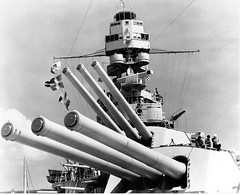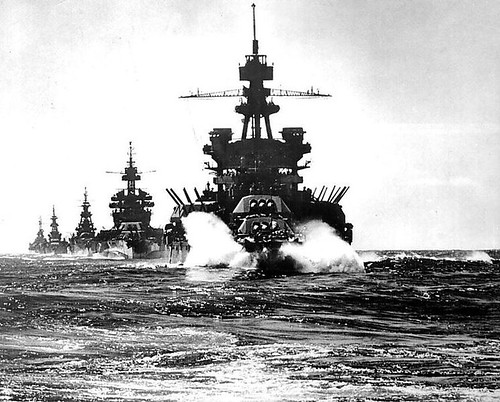 This is more of a reading assignment than anything else - this "summary" describes a ship's life in full.
This is more of a reading assignment than anything else - this "summary" describes a ship's life in full.When most people think of her, they think of her at her lowest point.
At 0755 on the morning of December 7, 1941, the USS PENNSYLVANIA was sitting in dry-dock in the Pearl Harbor Navy Yard. Her screws had been removed from their shafts and were resting on the bottom of the dock. She had been scheduled to leave the dock on the sixth and berth at Ten Ten Dock, immediately adjacent, but delays had been encountered, those delays probably saved the ship.But there is so much to her story. This is just a taste. From the start;
It was a normal quite Sunday morning and there was little activity aboard. The watch had just been set and the Chaplain was making preparations for the eight o'clock mass on the quarterdeck. Virtually all of the Ships Company were aboard. In view of the existing conditions general over-night liberty had not been granted.
Suddenly and with complete surprise, Japanese dive bombers and torpedo bombers roared out of the high overcast. The PENNSYLVANIA was one of the first ships in the harbor to open fire. Her 50 caliber machine gun crews had their guns in action even before General Quarters was sounded.
The PENNSYLVANIA was commissioned June 12, 1916, after having been authorized by Congress August 22, 1912. Her keel was laid on October 27, 1913, and she was launched at Newport News Shipbuilding Company, March 16, 1915. America's and the worlds biggest Battleship slid down the skids into her native element at 10:11 am while 20 thousand spectators cheered. Special trains from Pennsylvania, Maryland and Virginia brought thousands to Newport News. Governor Stewart of Virginia and Governor Brumbaugh of Pennsylvania and Secretary of the Navy Daniels, were among the honored guests.She survived to the next war - and executed her orders with style.
In the Fall of 1917 when Allied Naval Forces began collecting to form what was to be known as the Allied-British Grand Fleet, Sixth Battle Squadron, there was great unhappiness aboard the USS PENNSYLVANIA, flagship of the United States Fleet. The USS PENNSYLVANIA, together with the USS NEVADA joined the Fleet in 1916 as the first two oil burning U.S. Battleships, was told that she could not hope to operate with the forces seeking out the German Navy because she was "too modern". Only coal-burning dreadnaughts were to be included in the Allied Force because no tankers could be spared to carry fuel to the British Isles (a private note: that was good for my Grandfather - he served on the USS ARKANSAS (BB-33) in WWI).
At this time the PENNSYLVANIA had set a record of which she could well be proud. She was the only battleship to take part in every combat amphibious operation in the Pacific Ocean Areas and the two largest operations on the Southwest Pacific Area from May 4, 1943 to February 10, 1945, from Attu through Lingayen.Sad that she was nuked in the end - but seeing what has happened to USS Olympia in PA - perhaps it is better this way.
In the Guam Operation alone the PENNSYLVANIA expended not counting the false start on 16 June almost l800 rounds of l4", 10,000 rounds of 5", l4,000 rounds of 40mm and 1600 rounds of 20mm. This is probably a greater amount of ammunition than any other ship has ever fired during a single operation. And it was done without any personnel or material casualties.
Air spotters reported that the PENNSYLVANIA put out of action fifteen planes, six large guns, eight medium guns, three 5" guns, twelve 3" guns, nineteen dual purpose guns, two coast defense guns, eight large AA guns, four twin mounts, nine heavy AA guns, twelve machine guns, two anti-boat guns, numerous mortars, and much field artillery. The ship discovered and destroyed a very large ammunition storage near Adelup Point, at the time of the landing and permanently silenced them.
Since her first action at Pearl Harbor she has steamed almost 150,000 miles. Her self discipline had been excellent at all times, no man was ever lost overboard except by enemy action, she had never hit any friendly troops, installations, ships or planes and never had to report "not ready" for any operation. Nearly 150 officers and almost 1000 petty officers were trained and transferred from the PENNSYLVANIA during this period. She probably fired more ammunition than any other ship in history.
If I can part with one item to perhaps cause some reflection - and hopefully humble some.
In WWII, this is what it took for a Navy Unit Commendation.
"For outstanding heroism in action against enemy Japanese forces in the Pacific war area from May 4, 1943 to February 10, 1945. Operating under ten separate commands, the USS PENNSYLVANIA was the only battleship to take part in every amphibious operation during this period from Attu in the Northern area to Lingayen in the Philippines. Imperiled by perpetual fog, she served as flagship of the task force commander during the Aleutians campaign and navigated in poorly charted waters to deliver her accurate broadsides on predetermined but invisible targets; intensive fire from her batteries blazed the way for our assault waves in the Gilbert's, the Marshall's and the Mariana's silencing the enemy's heavy coastal guns, locating and neutralizing camouflaged emplacements and rendering steady support for our land forces. A gallant and dependable veteran, the PENNSYLVANIA completed nearly thirty years of unfailing service by her deadly close in bombardment and gun fire support in the recapture of the Philippines, fulfilling her prolonged and vital mission without casualty to herself or her personnel by Japanese fire. Handled superbly in the face of many obstacles throughout this period, the PENNSYLVANIA achieved an illustrious combat record, reflecting the courage, skill and brilliant teamwork of the Officers who plotted her course, the Pilots who spotted her gunfire and the operational force which aided in maintaining her fighting efficiency."

Thank you, CDR, for posting that! A great ship, reliable and well-handled. Couldn't ask for more.
ReplyDeleteThanks Phib, great post about a great ship. Both lucky and good. Once again our predecessors humble us.
ReplyDeleteJohnny Carson spent time aboard her late in the war...
ReplyDeleteI remember him talking about standing watch in after steering after she took a torpedo just after arriving aboard...he left out the other, more grave duties assigned to the most junior Ensign aboard....
Even the funny guys were Full Bore in those days.
As a postscript, two of the original 14-inch guns (removed during a 1945 overhaul) were found at Dahlgren and recently moved to a special exhibit at the PA Military Museum (in Boalsburg, near State College.
ReplyDeletehttp://pamilmuseum.org/Table/Battleship-Pennsylvania/